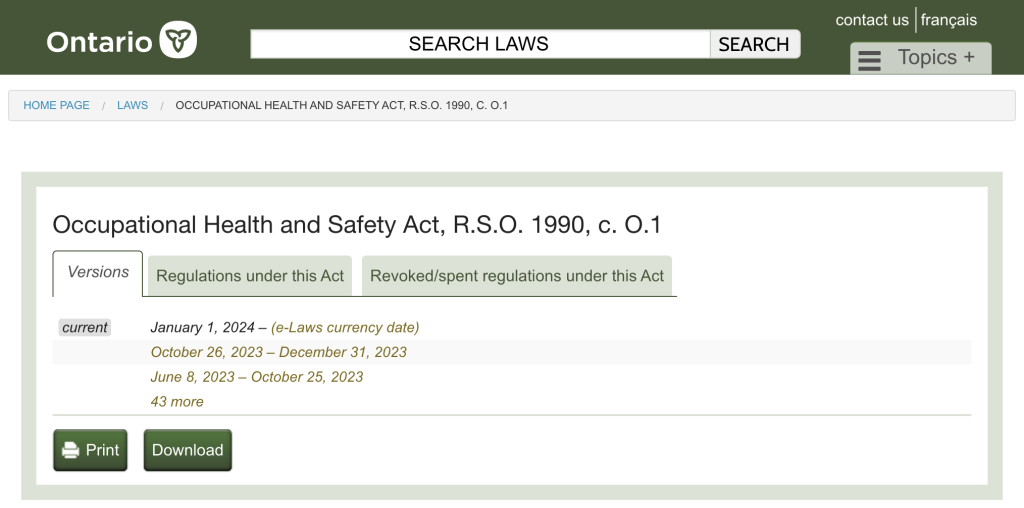Staying compliant with Ontario’s safety laws isn’t just a legal obligation—it’s essential for protecting your people and your business. Failing to follow workplace safety regulations can lead to serious injuries, costly fines, or even business closures. The good news? You don’t need to navigate these laws alone. This guide will walk you through the most important Ontario safety regulations and help you understand how to meet your responsibilities with confidence.
Here’s what you’ll learn:
- Key Responsibilities Outlined in the Occupational Health and Safety Act (OHSA)
- How to Safely Manage Hazardous Materials (WHMIS)
- When and Where To Use Personal Protective Equipment (PPE)
- Specialized Training and Certifications
If you have any questions or concerns regarding Ontario safety laws and regulations, contact ACUTE Environmental directly.
1. Key Responsibilities Outlined in the Occupational Health and Safety Act (OHSA)
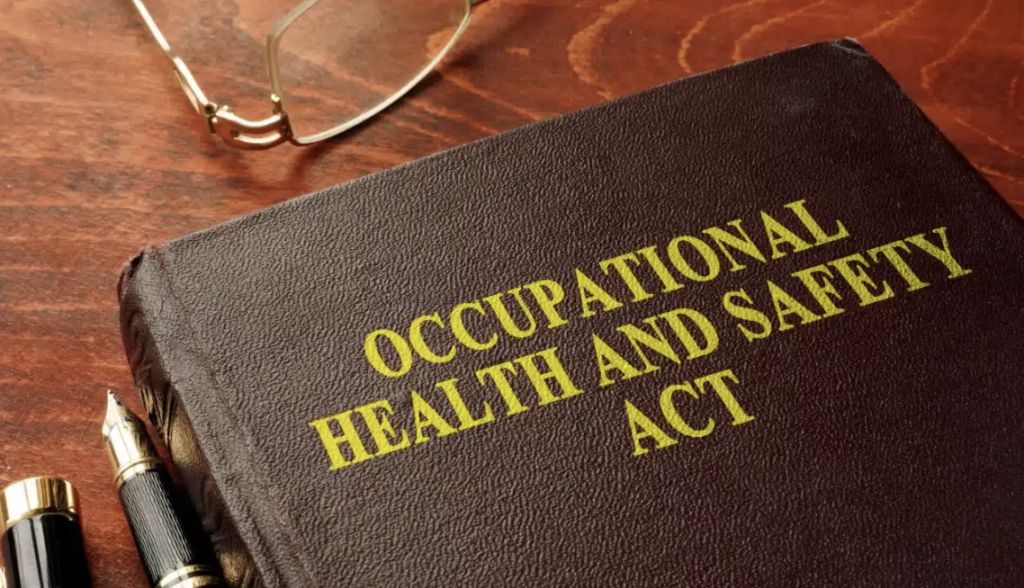
The Occupational Health and Safety Act is the primary legislation governing workplace health and safety in Ontario. It outlines the rights and responsibilities of employers, supervisors, and workers to ensure a safe working environment. Here are some key aspects and details about the OHSA:
A) Purpose and Scope
The primary goal of the OHSA is simple but critical: to protect workers from health and safety hazards on the job.
This foundational law applies to nearly every workplace in Ontario—from construction sites and factories to hospitals and office buildings. It outlines the rights and responsibilities of employers, supervisors, and workers, creating a legal framework for maintaining safe and healthy work environments across industries.
B) Rights and Responsibilities
The Occupational Health and Safety Act (OHSA) defines the roles and responsibilities of three key workplace parties:
1. Employers
Employers play the leading role in creating a safe work environment. Their responsibilities include:
-
Providing a safe and healthy workplace for all employees
-
Complying with the OHSA and all applicable regulations
-
Informing and training workers about potential hazards and safe work practices
2. Supervisors
Supervisors act as the link between employers and workers. They are responsible for:
-
Ensuring workers follow safe work practices
-
Making sure employees use required protective equipment properly
3. Workers
Workers also play a crucial role in maintaining safety. They are:
-
Entitled to refuse unsafe work if they believe it poses a danger
-
Expected to follow the OHSA, as well as the health and safety policies set by their employer
Together, these shared responsibilities help create a workplace culture where safety is everyone’s priority.
C) Workplace Committees and Representatives
Under the OHSA, workplaces with a certain number of employees must establish a Joint Health and Safety Committee or appoint a health and safety representative.
These committees and representatives are vital for:
-
Identifying and addressing workplace health and safety concerns
-
Raising awareness about potential hazards
-
Promoting education and safe work practices
For interactive and effective JHSC training, click here.
Both employers and employees should stay informed about the specific requirements of the OHSA and any industry-related regulations. Ongoing training and strict compliance are key to maintaining a safe and healthy workplace in Ontario.
2. How to Safely Manage Hazardous Materials (WHMIS)

The Workplace Hazardous Materials Information System (WHMIS) is a critical part of Ontario’s workplace safety laws. It’s a system designed to ensure that employers provide clear, accessible information about hazardous materials used on the job.
The three key components of WHMIS are:
-
Labels – Clear warnings and hazard symbols on containers
-
Safety Data Sheets (SDS) – Detailed information about each substance’s risks, handling, and emergency procedures
-
Worker Training – Education on how to safely use, store, and respond to hazardous materials
By following WHMIS guidelines, employers help protect workers from chemical exposure and ensure a safer, more informed workplace.
WHMIS is a set of regulations that require employers to provide information about hazardous materials used in the workplace. It includes labelling, safety data sheets (SDS), and worker training.
A) Objective of WHMIS
WHMIS aims to protect the health and safety of workers by providing them with information about hazardous materials in the workplace.
The system ensures that workers are aware of the hazards associated with the materials they work with and that they have the knowledge to handle them safely.
B) Classification of Hazardous Materials
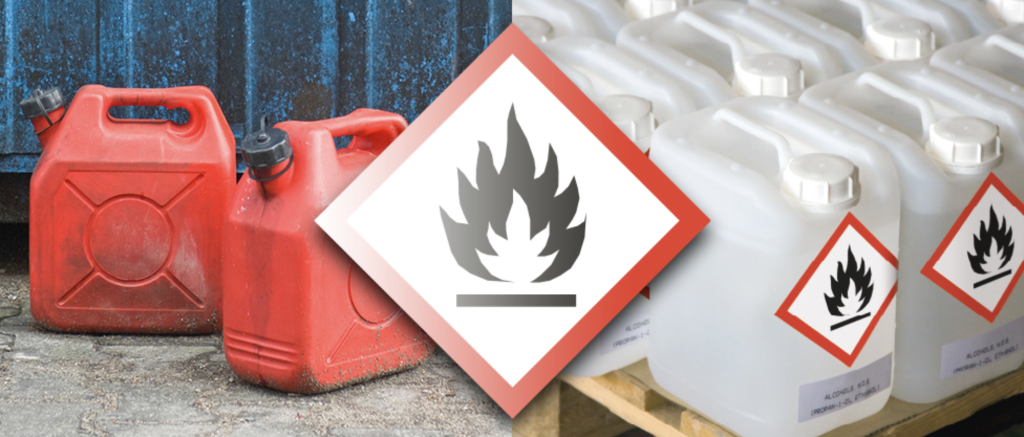
WHMIS also classifies hazardous materials into specific categories based on their physical and health risks. These categories help standardize how hazards are identified and communicated across workplaces.
Common WHMIS hazard classes include:
-
Flammable materials – Substances that can easily ignite
-
Corrosive substances – Materials that can cause damage to skin, eyes, or metals
-
Toxic materials – Chemicals that may cause serious health effects through inhalation, ingestion, or skin contact
-
And more, including gases under pressure, oxidizing agents, and biohazardous infectious materials
Understanding these classifications helps workers quickly identify dangers and take the necessary precautions to stay safe on the job.
For an explanation of each WHMIS symbol, check out our article “WHMIS Meaning: Icons Explained”.
C) Labels
Under Ontario safety laws, employers must ensure that all hazardous material containers are properly labeled in the workplace. These labels are more than just a legal requirement—they’re a vital tool for keeping workers safe.
Every WHMIS label must include:
-
Product identifiers – The name of the substance
-
Hazard symbols – Standardized icons that indicate the type of risk (e.g., flammable, toxic, corrosive)
-
Precautionary measures – Key steps for safe handling, storage, and emergency response
These labels offer a quick visual warning, helping workers recognize risks at a glance and take immediate precautions. It’s a small step that can prevent serious injuries—and even save lives.
D) Safety Data Sheets (SDS)
Employers in Ontario are legally required to obtain or prepare a Safety Data Sheet (SDS) for every hazardous material used in the workplace.
An SDS provides detailed, easy-to-reference information about each substance, including:
-
Physical and chemical properties
-
Health and safety hazards
-
Safe handling and storage procedures
-
Emergency response and first aid measures
-
Disposal guidelines
Unlike labels, which offer a quick overview, SDS documents give workers and supervisors the full picture, ensuring everyone knows how to work safely with hazardous materials and what to do in case of an emergency.
Workers have the right to access SDS to be informed about the materials they are working with. To understand how to read a Safety Data Sheet, read our article “SDS – How to Read”
In Ontario, WHMIS is a cornerstone of workplace safety, ensuring that everyone—from employers to front-line workers—has the knowledge and tools to handle hazardous materials responsibly.
Through a combination of:
-
Clear labelling
-
Detailed documentation (SDS)
-
Ongoing, practical training
WHMIS helps minimize risks and prevent accidents involving workplace chemicals and substances. Successful implementation requires collaboration between employers, workers, and suppliers, all working together to maintain a safe, informed, and compliant environment.
3. When and Where To Use Personal Protective Equipment (PPE)
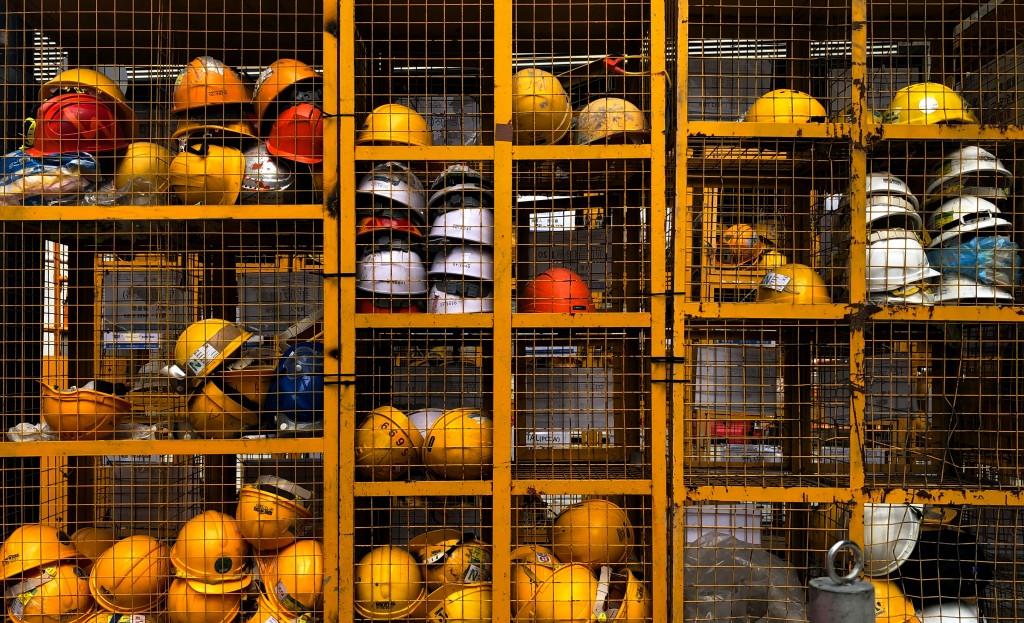
Personal Protective Equipment (PPE) refers to specialized clothing or gear worn by workers to protect against specific workplace hazards—from flying debris and chemical exposure to loud noise and biohazards.
In Ontario, the use of PPE is governed by strict regulations to safeguard worker health and safety. Employers are required to:
-
Assess workplace hazards to determine the appropriate PPE
-
Provide and maintain the necessary equipment at no cost to employees
-
Train workers on proper PPE use, maintenance, and limitations
Whether it’s safety goggles, gloves, steel-toed boots, or respiratory protection, PPE is often the last line of defence when other hazard controls can’t eliminate the risk.
A) Hazard Assessment
Before assigning PPE, employers must first conduct a thorough hazard assessment of the workplace. This assessment identifies potential risks—such as chemical exposure, sharp objects, falling debris, or loud noise—that could pose a threat to workers’ health and safety.
Based on the results, employers are responsible for:
-
Determining the appropriate type of PPE needed for each task or work area
-
Ensuring the selected PPE fits properly and offers adequate protection
-
Providing PPE at no cost to employees and replacing it as needed
A proper hazard assessment is the foundation for effective PPE use—and a key step in preventing avoidable injuries.
For example, if you employ welders, ensure that they are equipped with welding helmets to protect them from arc flash and radiation.
B) Selection and Provision of PPE
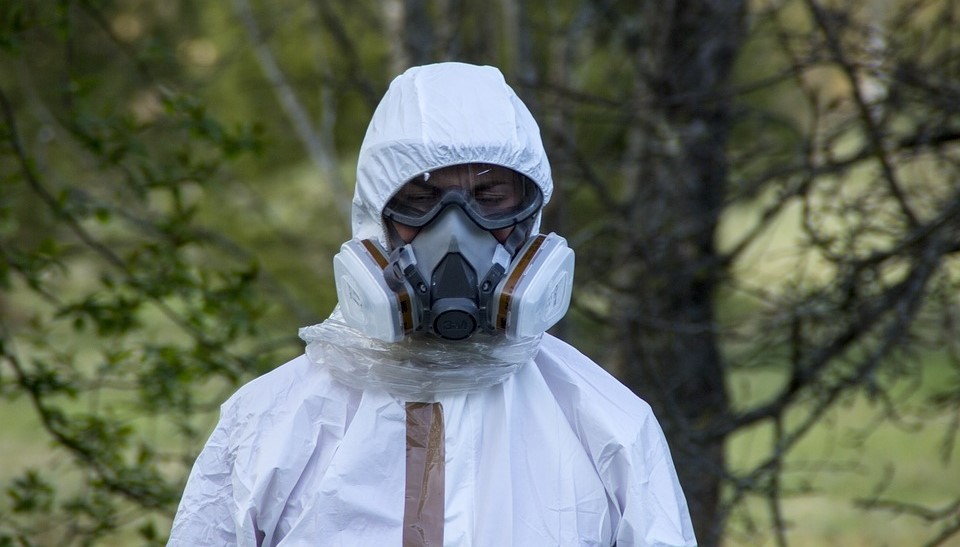
Under Ontario safety regulations, employers are required to select and provide appropriate PPE to workers—at no cost. The equipment must be:
-
Suited to the specific hazards identified in the workplace
-
Properly fitted to each employee
-
Well-maintained and in good working condition
For example, if workers are exposed to respiratory hazards, employers must provide certified masks or respirators that meet regulatory standards. In such cases, additional responsibilities include:
-
Training employees on how to properly use, maintain, and store respiratory PPE
-
Conducting fit-testing to ensure an effective seal and proper protection
Ultimately, it’s the employer’s duty to ensure that PPE is not just available, but also effective and used correctly.
C) Training and Instruction
Providing PPE isn’t enough—employers must also train workers on how to use it properly. Ontario safety laws require that this training cover:
-
Proper use – How to wear and operate PPE correctly
-
Care and maintenance – How to clean, store, and inspect equipment
-
Limitations – Understanding what PPE can and cannot protect against
This training helps ensure that workers use their protective gear effectively and confidently, reducing the risk of accidents or misuse.
By regulating PPE use and training through Ontario’s safety laws, the goal is clear: to keep workers safe from preventable hazards. But safety is a shared responsibility—employers must provide the tools and education, while workers must use PPE consistently and correctly to help maintain a safe and healthy workplace.
4. Specialized Trainings and Certifications

Some specific scenarios in the workplace require specialized training or equipment to ensure the safety of employees. Here are some examples:
A) Using Forklifts
Operating a forklift is a high-risk task that requires specialized training and certification to ensure safety on the job site. Proper training helps protect not only the operator but also coworkers, pedestrians, and nearby equipment.
Under Ontario’s Occupational Health and Safety Act (OHSA) and related regulations, forklift operators must be certified before they can legally operate this type of machinery.
Certification involves:
-
Completing a recognized forklift safety training course
-
Demonstrating knowledge of safe operating procedures
-
Passing both written and practical evaluations
This training ensures that operators understand how to safely maneuver, load, and maintain a forklift—and how to respond in case of an emergency.
B) Working at Heights
Working at heights—whether on ladders, scaffolds, roofs, or elevated platforms—presents serious risks. To prevent falls and ensure safety, Ontario law mandates specific training and certification for workers in these environments.
According to provincial regulations, employees must complete:
-
Working at Heights (WAH) Training – Required for construction and other high-risk industries
-
Fall Protection Training – Covers proper equipment use and hazard awareness
These training programs typically include instruction on:
-
Correct use of fall protection equipment (harnesses, lanyards, anchors, etc.)
-
Identifying fall hazards in the workplace
-
Emergency response and rescue procedures
Employers are responsible for ensuring all at-height workers are properly certified and that training is kept up to date.
C) Working with Dangerous Materials
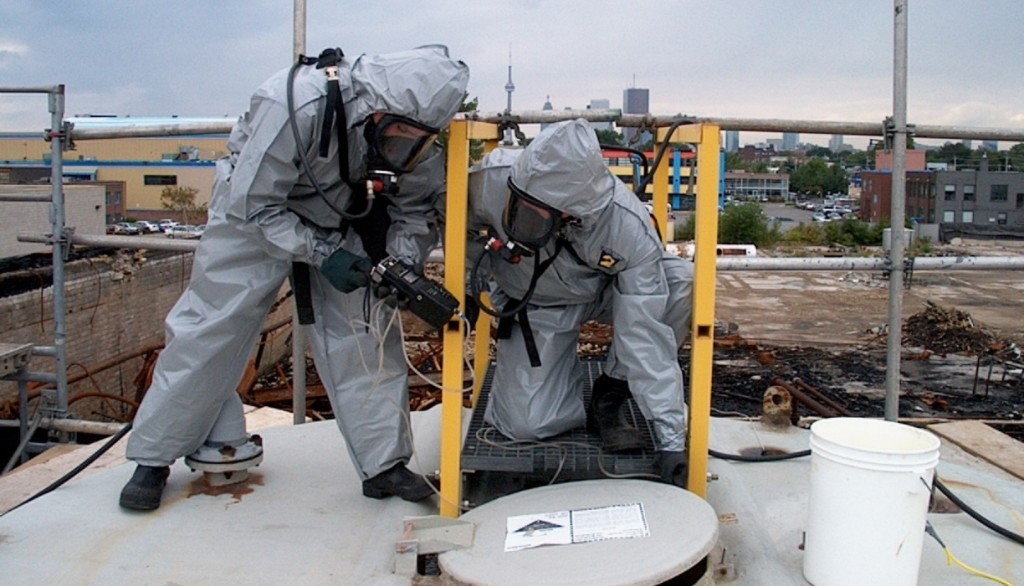
Employees who work with hazardous materials must receive proper training to ensure they can safely store, handle, and dispose of these substances, protecting both themselves and the environment.
This training should cover:
-
The properties and risks of the hazardous materials involved
-
Safe handling and storage practices
-
Emergency response procedures for spills, leaks, or exposure
In some cases, HAZWOPER (Hazardous Waste Operations and Emergency Response) certification may be required, especially in workplaces dealing with hazardous waste or cleanup operations. Certification requirements can vary depending on:
-
The type and quantity of hazardous materials
-
The nature of the worksite (e.g., industrial plant, cleanup site)
-
Relevant federal and provincial regulations
Employers must evaluate the risks in their specific workplace and ensure workers are adequately trained and certified based on those hazards.
D) Confined Space Entry
Confined spaces—like tanks, tunnels, silos, or vaults—pose unique and serious hazards, including limited airflow, toxic gases, and restricted exits. To protect workers, Ontario regulations require specialized training and certification before anyone enters these environments.
Mandatory certifications may include:
-
Confined Space Entry Training – Teaches how to recognize confined spaces, assess risks, and enter safely
-
Confined Space Rescue Training – Prepares workers to respond quickly and effectively in emergency situations
Training typically covers:
-
Hazard identification and risk assessment
-
Atmospheric testing and monitoring
-
Use of personal protective and respiratory equipment
-
Safe entry and exit procedures
-
Emergency rescue plans
Employers must ensure all workers entering confined spaces are properly trained, equipped, and certified, and that rescue procedures are in place and regularly practiced.
E) First Aid and CPR

Having trained personnel on-site who can respond to medical emergencies is an essential part of workplace safety. Employees with First Aid and CPR certification can provide critical assistance in the event of an injury, sudden illness, or life-threatening situation.
Certification Requirements:
Ontario safety laws require that workplaces have a designated number of employees certified in:
-
Standard First Aid
-
Cardiopulmonary Resuscitation (CPR)
These certifications must be obtained through recognized organizations, such as:
-
The Canadian Red Cross
-
St. John Ambulance
-
Other provincially approved training providers
Training ensures that workers are prepared to:
-
Respond quickly to workplace incidents
-
Stabilize injuries until emergency responders arrive
-
Potentially save lives in time-sensitive situations
Employers are responsible for ensuring that certifications are up to date and meet provincial regulations based on the size and risk level of the workplace.
F) Lockout/Tagout Procedures
Lockout/Tagout (LOTO) procedures are critical for protecting workers who service or maintain machinery. These practices prevent the unexpected start-up or release of stored energy, which can lead to serious injury or death.
Who Needs This Training?
Any employee involved in maintaining or repairing equipment where hazardous energy could be released must receive LOTO training and certification.
Certification Covers:
-
Recognizing hazardous energy sources (electrical, mechanical, hydraulic, etc.)
-
Proper lockout and tagout procedures
-
Verifying that energy is fully isolated before work begins
-
Restoring equipment to service safely
Employer Responsibilities:
-
Ensure compliance with Ontario safety laws and industry-specific standards
-
Provide up-to-date, job-specific training
-
Partner with recognized training providers to meet legal requirements
Since certification requirements may vary by industry and jurisdiction, employers should regularly review applicable regulations and ensure all affected workers are properly trained and authorized.
Need Safety Training? Rely on ACUTE Environmental
ACUTE can transform your workplace to be more safety-compliant.
If you have any questions regarding Ontario safety laws or you are concerned that your workplace is not safety compliant, book a course with ACUTE. Here are some of the benefits of working with ACUTE:
- Open Door Instructor-Student Partnership – ACUTE’s training services emphasize client participation, staff foster relationships with clients and serve as a touchstone for advice anytime moving forward.
- Serving Your Team and Industry – With a vast array of clients in manufacturing, construction, health, academic, and government sectors, ACUTE brings the best safety practices from across the spectrum to your workplace.
- 100 Years Combined Experience – ACUTE provides comprehensive health and safety training, on-site safety services, and consulting services. With over 100 years of combined experience, our company staff offers more than theoretical or abstract ideas. ACUTE offers solutions!
- Track Record of Success – ACUTE is rated 4.9/5 stars on Google reviews, demonstrating our commitment to our clients, our quality, and our passion for training.
It is one thing to understand what HSE is and another to know how to conduct an HSE presentation. Contact Acute Environmental today to learn more about health, safety, and the environment.
What Our Customers Are Saying…
We were referred to ACUTE on behalf of our employer for an n95 mask fitting – the staff here are professional, personable, and informative.
I’d come back here for any safety-related training in a heartbeat.
Acute has been a staple in supporting my companies over the years and have always delivered quality and dependable service. Training programs are top shelf and a great facility for practical application. couldn’t recommend them more. keep up the great work folks.
Outstanding service provided by Acute, right from the customer support end, right through to the delivery of the session. Always professional, quick to respond, and always delivering services that exceed my expectations. Acute has an amazing team that is always helping us achieve better health and safety performance. So are grateful to have such a tremendous resource in Acute!
Hours of Operation and Contact Information:
Monday-Friday: 8:00 AM – 5:00 PM
Saturday-Sunday: Closed
Phone: (519) 747-5075
Fax: (519) 747-4608
Email: info@acuteservices.com

